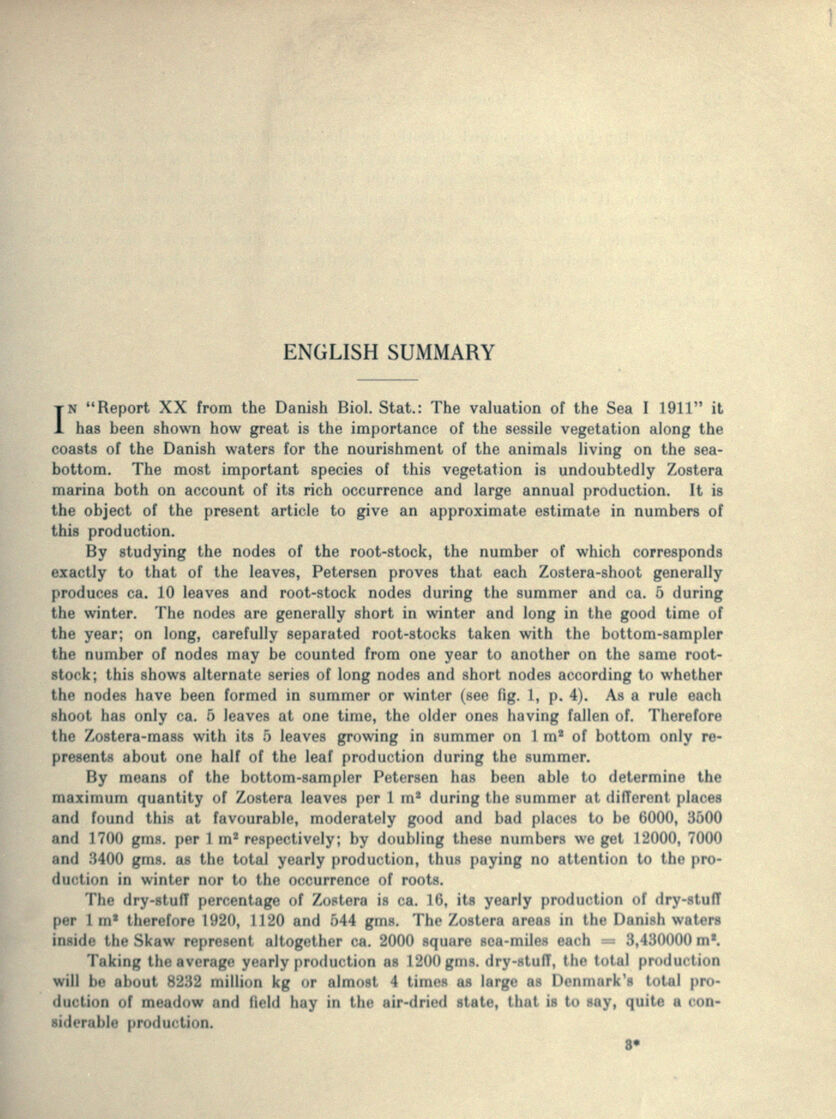
Full resolution (JPEG)
- On this page / på denna sida
- ENGLISH SUMMARY

<< prev. page << föreg. sida << >> nästa sida >> next page >>
Below is the raw OCR text
from the above scanned image.
Do you see an error? Proofread the page now!
Här nedan syns maskintolkade texten från faksimilbilden ovan.
Ser du något fel? Korrekturläs sidan nu!
This page has been proofread at least once.
(diff)
(history)
Denna sida har korrekturlästs minst en gång.
(skillnad)
(historik)
ENGLISH SUMMARY
In “Report XX from the Danish Biol. Stat.: The valuation of the Sea I 1911” it
has been shown how great is the importance of the sessile vegetation along the
coasts of the Danish waters for the nourishment of the animals living on the
seabottom. The most important species of this vegetation is undoubtedly Zostera
marina both on account of its rich occurrence and large annual production. It is
the object of the present article to give an approximate estimate in numbers of
this production.
By studying the nodes of the root-stock, the number of which corresponds
exactly to that of the leaves, Petersen proves that each Zostera-shoot generally
produces ca. 10 leaves and root-stock nodes during the summer and ca. 5 during
the winter. The nodes are generally short in winter and long in the good time of
the year; on long, carefully separated root-stocks taken with the bottom-sampler
the number of nodes may be counted from one year to another on the same
root-stock; this shows alternate series of long nodes and short nodes according to whether
the nodes have been formed in summer or winter (see fig. 1, p. 4). As a rule each
shoot has only ca. 5 leaves at one time, the older ones having fallen of. Therefore
the Zostera-mass with its 5 leaves growing in summer on 1 m2 of bottom only
represents about one half of the leaf production doling the summer.
By means of the bottom-sampler Petersen has been able to determine the
maximum quantity of Zostera leaves per 1 m2 during the summer at different places
and found this at favourable, moderately good and bad places to be 6000, 3500
and 1700 gms, per 1 m2 respectively; by doubling these numbers we get 12000, 7000
and 3400 gms. as the total yearly production, thus paying no attention to the
production in winter nor to the occurrence of roots.
The dry-stuff percentage of Zostera is ca. 16, its yearly production of dry-stuff
per 1 m2 therefore 1920, 1120 and 544 gms. The Zostera areas in the Danish waters
inside the Skaw represent altogether ca. 2000 square sea-miles each = 3,430000 m2.
Taking the average yearly production as 1200 gms. dry-stuff, the total production
will be about 8232 million kg or almost 4 times as large as Denmark’s total
production of meadow and field hay in the air-dried state, that is to say, quite a
considerable production.
<< prev. page << föreg. sida << >> nästa sida >> next page >>
Project Runeberg, Sun Dec 10 11:29:28 2023
(aronsson)
(diff)
(history)
(download)
<< Previous
Next >>
https://runeberg.org/japetus100/ix/0019.html



